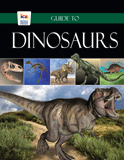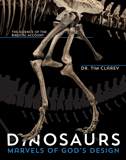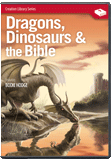Did Dinosaurs Shrink to Become Anteaters and Birds?
How some scientists claim the alvarezsaur species shrank over millions of years to eventually become bird-like insectivores—and a biblical creation response to the available data
A recent news article mentioned the incredible downsizing of one group of carnivorous dinosaurs, the alvarezsaurs. Alvarezsaurs were small, light, and fast theropods, with the largest (Bonapartenykus ultimus) being about 8.5 feet (2.6 meters) long from snout to tail. According to secular paleontologists, there are 21 confirmed species of alvarezsaurs conventionally dated from Late Jurassic, around 160 million years ago, to the end of the Cretaceous, around 66 million years ago. Both body size and weight are believed to have been drastically reduced between 110 million and 85 million years ago. Additionally, alvarezsaurs seemed to rapidly speciate starting at 90 MY ago.
Rapid Weight Loss Program
The earliest alvarezsaurs known is Haplocheirus sollers. It weighed up to 110 pounds (50 kg) but later alvarezsaurs quickly slimmed down to under 11 pounds (5 kg), with one species shrinking to just 0.3 pounds (0.15 kg). Assuming the evolutionary relationship among alvarezsaurs, the researchers point out that the “ancestral body mass of alvarezsauroids is around 23 kg. From 110 to 85 Ma (Albian to Santonian), mean body size along the alvarezsauroid stem plunged rapidly to a very small mean body mass of <5 kg. Some of these miniaturized alvarezsauroids are in fact among the smallest nonavialan dinosaurs known, weighing <0.5 kg.”1
However, contrary to this paper’s downsizing claim, one of the latest alvarezsaurs, Bonapartenykus ultimus (Late Cretaceous), was about 8.2 feet long (2.5 m) and weighed about 158 pounds (72 kg), by far the largest.2 Kol ghuva (Late-end Cretaceous), estimated at 5.9–7.9 feet (1.8–2.4 m) and 44–53 pounds (20–24 kg), was the third-largest member of the group. Yet, two of the earliest (from the Late Jurassic) were Aorun zhaoi, at 3.3 feet (1 m) long and weighing 4.4 pounds (2 kg), and Shishugounykus inexpectus, which weighed 15 pounds (6.8 kg). They were some of the smaller to medium-sized alvarezsaurs, showing that some of the earliest species were lighter than some of the later ones.
Believing that all fossil finds of (assumed) alvarezsaurs are evolutionarily related, researchers are puzzled as to what could have caused the rapid (in evolutionary time) size and weight loss and diet change (from carnivores to insectivores) for these alvarezsaurs.
Believing that all fossil finds of (assumed) alvarezsaurs are evolutionarily related, researchers are puzzled as to what could have caused the rapid (in evolutionary time) size and weight loss and diet change (from carnivores to insectivores) for these alvarezsaurs. Appearing in Current Biology, lead author of the technical paper, Zichuan Qin, told Live Science, “Size reduction is very uncommon in Cretaceous theropod dinosaurs. At this time, most other dinosaurs were getting bigger, and the only other group to decrease in size was the theropod lineage that eventually evolved into modern-day birds.”3
To ensure that they were not misinterpreting young juvenile fossils as fully mature adults (and thus skewing the size estimates), the researchers decided to take and microscopically examine thin sections of alvarezsaur bone from the femur or tibia. Utilizing their own fossils as well as bone-thin sections available from other researchers, they were able to look at eight different alvarezsaur species. By comparing and contrasting growth rings, porosity, density, bone-fiber orientation, and other factors, the researchers were able to establish (with reasonable certainty) the approximate age of each dinosaur at death. Only one specimen was a hatchling, Aorun zhaoi, and the researchers excluded that data from the analysis as they were unable to provide a practicable estimation of its adult mass.
What Caused the Size and Weight Reduction?
So what would explain this radical size and weight decrease in the evolutionary model? According to the authors of the journal, it was to exploit a recently opened dietary niche. There is no doubt that in isolated environments insular dwarfism can and does occur. Insular dwarfism may be described as a shrinking process attributable to the stresses of a small island environment, usually because of lack of prey for the species, sometimes to carve out a dietary niche with less competition (as the Current Biology authors believe in this case) or occasionally because of predation upon the species (size decreases in order to exploit protective geography like dens or rock shelters). Isolated geographical locations are key hotspots for founder effect and genetic drift. But none of these processes are examples of molecules-to-man evolution.
However, there can be no appeal to insular dwarfism here because, in the evolutionary model, alvarezsaurs lived in varied environments spread across the globe (Europe, Asia, North and South America). So can the authors really expect that most of the mid-to-late Cretaceous alvarezsaurs simply decided to shrink to accommodate a diet change? Yes, that’s exactly what they claim.
The suggested alvarezsauroid miniaturization and associated phylogenetic radiation are coincident with the emergence of ants and termites, and combining previous functional morphological data, our study suggests that alvarezsauroid miniaturization might have been driven by ecological changes during the Cretaceous Terrestrial Revolution, more specifically by a shift to the myrmecophagous [ant and termite-eating] ecological niche.4
And why would these dinosaurs who lived all over the world, according to evolutionary paleontologists, suddenly decide to switch diet as an entire group? Well, the answer to that lies in evolutionists’ belief that termites became eusocial, living in colonies at this time.
There is further evidence for alvarezsauroid myrmecophagy from the insect fossil record. This shows that true eusocial insects, the termites, began to flourish as part of the Cretaceous Terrestrial Revolution (KTR). Morphological specializations of the different termite castes and even large eusocial aggregations of termites were recently reported in mid-Cretaceous Burmese amber, revealing an unanticipated flourishing of eusocial termite societies then. These prosperous termite colonies from the mid- to Late Cretaceous might have made an obligate myrmecophagous ecological niche possible. Earlier macroevolutionary studies of dinosaurs rarely exhibited cases of coevolution and ecological interaction during the KTR. We suggest that at least the two miniaturized theropod lineages, alvarezsauroids, and birds, responded to this global environmental change with major changes in body form accompanying ecological niche shifts to previously unexplored ecomorphologies. Evidence from phylogenomic reconstruction of insect phylogeny supports these diversifications of eusocial insects during the KTR.5
Does This Interpretation Make Any Sense?
To map out the above two quotations and summarize the evolutionary interpretation, let’s review. Alvarezsaurs (with several statistical outliers that don’t fit the trend) as a group underwent dramatic size and weight reduction from 110 MY–85 MY ago. The researchers then noted that Burmese amber fossils contain numerous insects, including large numbers of termites. Burmese amber is dated (using U-Pb dating of the zircons in the surrounding rock matrix) at ~99 MY.6 Although eusocial behavior (colonial, caring for young and caste-based division of labor) is thought to have occurred in termites much earlier, the Burmese amber contains the first direct fossil evidence of eusocial termite colonies. Therefore, according to the authors of this study, evolutionists believe that they have found the smoking gun. Why fight (and possibly get injured) going after smaller reptiles and mammals when you can just gorge on termites? Why not just shrink down so that you can more easily have access to termite mounds and conversely also need less food mass due to a reduced body size?
Using observational science on extant animals today, we can see several holes in this line of logic.
But using observational science on extant animals today, we can see several holes in this line of logic. Some of the main (and specialized) termite eaters are Giant anteaters (60–140 pounds or 27–64 kg), Giant armadillos (41–72 pounds or 19–33 kg), and aardvarks (130–180 pounds or 60–80 kg), which would not be considered small mammals. Honey badgers (11–35 pounds or 5–16 kg), aardwolves (15–33 pounds or 7–15 kg), and nine-banded armadillos (5.5–14.3 pounds or 2.5–6.5 kg) are likewise considered medium-sized mammals. Black-throated and Nile monitor lizards (the fifth and sixth largest extant lizards) are also termite mound raiders (ranging in weight from 13–60 pounds or 6–27 kg). And there are many other large amphibians, reptiles, and birds which are opportunistic termite eaters. Admittedly, lots of smaller animals eat termites, and perhaps the biggest termite threats are ants. So, downsizing to become a termite eater doesn’t match what we see today. Additionally, downsizing has its own drawbacks, mainly that it increases the likelihood of predation by larger species.
The authors also seem to be rather optimistic in their confidence in termite mounds and termite eusocial behavior during the Cretaceous, in opposition to other evolutionary biologists. For example, in 2008, Longrich and Curry wrote, “[W]hile it seems plausible to propose that alvarezsaurids used their forelimbs to tear open above-ground termite mounds, this hypothesis has serious flaws. First, body fossils of the advanced, mound-building termites, the Termitidae, first appear in the Eocene. Even if the Termitidae did evolve in the Cretaceous, they must have been relatively rare to escape preservation; this makes it unlikely that they were abundant enough to support specialized termite predators.”7 But in fairness, there have been a few examples of caste-based termites (workers and soldiers) preserved in Burmese Amber.1 Yet, Burmese amber records a very small percentage of termites—less than 1% of all amber fossils found—and the fact that only 15 individual specimens were recovered showing such eusocialistic characteristics would argue against the evolutionary position of their being in large enough numbers to sustain a specialized dietary niche.
Over-Competition Drives Dietary Adaptation by Two Groups?
From an evolutionary point of view, it makes no sense to “downsize” to a particular ecological niche if another group of animals worldwide is doing the same thing.
Also notice that twice the authors refer to another group that was downsizing at this time: paravians, the lineage that (according to evolutionary thought) led to modern birds. From an evolutionary point of view, it makes no sense to “downsize” to a particular ecological niche if another group of animals worldwide is doing the same thing. Where is the survival advantage in becoming smaller, and more likely to be preyed upon, in order to gain a dietary niche that has already been exploited by another group that supposedly downsized previously or contemporaneously? According to evolutionary timelines, paravians diverged from other maniraptorans about 160 MYA, and the ancestors of modern birds diverged from other paravians at approximately 95 MYA, supposedly around the time alvarezsaurs were rapidly speciating and becoming the size of small to mid-sized birds. Not only do evolutionary biologists have to assume one group of animal’s downsizing and speciating, but they also have to assume two groups “evolved” this way convergently. And both groups end up with similar body plans (except wings instead of hands for birds) to exploit a dietary niche which now would be overcrowded with competitors worldwide. And other than assuming that this evolution happened, they have no driving mechanism and no reason why natural selection would favor this rapid reduction in size and weight.
Additionally there is much controversy among paleontologists about which species are considered alvarezsaurs. In the current study, the authors also excluded Kol ghuva because (according to them) the holotype of Kol ghuva has very few characters supporting alvarezsauroid affinities. Yet, the authors who first described Kol ghuva seem to be quite confident in their designation: “A close inspection of the morphology of Kol ghuva does document a previously unutilized variation that appears characteristic of the most derived Asian alvarezsaurids. This variation includes the dorsally placed flange on the lateral side of MT IV. Also shared among these Asian alvarezsaurids, and possibly more basal alvarezsaurids, is the development of deep and proximally expanded extensor pits on the phalanges of digit 4.”9
Even the authors of the Current Biology paper admit that there are distinct morphological differences between “early” alvarezsaurs and “later” ones. “This sharp decrease in size may be related to some of the bizarre alvarezsauroid modifications seen only in the Late Cretaceous late-branching species. Though morphological modification of alvarezsauroids started early, in the Late Jurassic, some typical features are found only in Late Cretaceous forms, such as the highly modified hand, keeled sternum, and the atypical vertebrae (strongly opisthocoelous cervical centra, opisthocoelous dorsal centra, and fused sacral centra with ventral kneels, commonly seen in tiny members, but also some indication in Patagonykus and Xiyunykus).”10
A More Reasonable Explanation
From a creation perspective, we must first recognize that where most fossils are found says little to nothing about where the animal actually lived—merely where it was buried.
From a creation perspective, we must first recognize that where most fossils are found says little to nothing about where the animal actually lived—merely where it was buried. Of course, there are exceptions, like frozen mammoths, mummified cave bears, lions, bog and tar pit remains, and so on. But those are clearly post-flood fossils. From a flood geology perspective, most fossils have been transported by water or sediment, and their place of origin (on a flood-devasted planet) is practically impossible to determine.
We also know from Scripture that insects were created on day 6 (with the possible exception of flying insects created a day earlier) and most likely had eusocial behavior (for the ones which exhibit it) right away or as an early post-fall adaptation. We also know that the radiometric dating methods are flawed, built on assumptions, and ignore the global flood as a factor. Even in a naturalistic paradigm, there would have been no selective pressure (like geographical isolation acting upon a limited gene pool through founder effect) to cause them to shrink and go termite hunting.
Last, the seven species which had the most “dramatic shrinking” show several different morphological characteristics from the earlier and larger alvarezsaurs. Perhaps that’s because they are not the same created kind but a separate created kind that was specialized for insect-eating. However, because of a built-in assumption of common descent (which is stressed by their phylogenetic tree placement of alvarezsaurs) and the need to miniaturize theropods to “turn them into birds,” they have downsizing clouding their assumptions. When you peel away the evolutionary assumptions, the actual data makes much more sense and shows that there were (at least) two unrelated lineages in question.11 The late Cretaceous lineages were not related to the late Jurassic and early Cretaceous ones, though they would have all lived contemporaneously and been buried by the flood in different layers, likely based on ecological zone. In addition, many of the later Cretaceous alvarezsaurs are believed to be birds by preliminary studies of creation scientists. In other words, they were a completely different biblical kind. No need for unjustified evolution or massive shrinking, just different created kinds doing what they were created to do in a post-fall world.
Footnotes
- Zichuan Qin et al., “Growth and Miniaturization among Alvarezsauroid Dinosaurs,” Current Biology 31 (August 23, 2021): 2, https://doi.org/10.1016/j.cub.2021.06.013.
- Qin et al., “Alvarezsauroid Dinosaurs.”
- Harry Baker, “Bizarre dinosaurs rapidly shrank to become ant-eaters the size of a chicken,” July 08, 2021, https://www.livescience.com/bizarre-dinosaurs-rapidly-shrank-in-size.html.
- Qin et al., “Alvarezsauroid Dinosaurs,” 1.
- Qin et al., “Alvarezsauroid Dinosaurs,” 5.
- Guanghai Shi, “Age constraint on Burmese amber based on U–Pb dating of zircons,” Cretaceous Research 37 (October 2012): 155, https://www.sciencedirect.com/science/article/abs/pii/S0195667112000535.
- Nicholas R Longrich and Philip Currie, “Albertonykus Borealis, a New Alvarezsaur (Dinosauria: Theropoda) from the Early Maastrichtian of Alberta, Canada: Implications for the Systematics and Dcology of the Alvarezsauridae,” Cretaceous Research 30 (2009): 249, ttps://doi.org/10.1016/j.cretres.2008.07.005
- Michael S.Engel, et al., “Morphologically Specialized Termite Castes and Advanced Sociality in the Early Cretaceous,” Current Biology 26, no. 4 (February 2016): 522, https://www.sciencedirect.com/science/article/pii/S0960982216000427.
- lan H. Turner, Sterling J. Nesbitt, and Mark A. Norell, “A Large Alvarezsaurid from the Late Cretaceous of Mongolia,” American Museum of Natural History: American Museum Novitates, No. 3648 (June 25, 2009): 12.
- Qin et al., “Alvarezsauroid Dinosaurs.”
- For the record, the smaller alvarezsaurs considered termite-eaters are Ceratonykus oculatus, Linhenykus monodactylus, Mononykus olecranus, Nemegtonykus citus, Parvicursor remotus, Qiupanykus zhangi, Shuvuuia deserti, Xixianykus zhangi, Xiyunykus pengi and Albinykus bataar.
Recommended Resources

Answers in Genesis is an apologetics ministry, dedicated to helping Christians defend their faith and proclaim the good news of Jesus Christ.
- Customer Service 800.778.3390
- © 2024 Answers in Genesis








